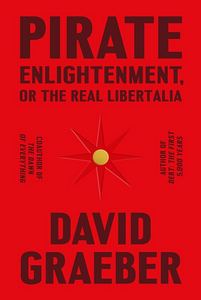Book reviews – Graeber, Roth/Cengiz, O’Brien
Pirate Enlightenment, Or The Real Libertalia. By David Graeber, Penguin, 2024
The Age of Enlightenment is usually said to be the intellectual movement that occurred mainly in Europe in the seventeenth and eighteenth centuries, based on knowledge learned by reason and evidence. Graeber argues that the Enlightenment did not begin in Europe and that its true origins are to be found on the island of Madagascar, in the late seventeenth century, when it was home to several thousand pirates. This was in the Golden Age of Piracy which lasted no more than fifty years, but it was also an experiment in radical democracy as the pirate settlers attempted to apply the egalitarian principles of their ships to a new society on land. Those also involved were Malagasy women, merchants, traders and escaped slaves. They were exploring ideas that were ultimately to be put into practice in Europe a century later.
This short book was first written to be a chapter of a book on ‘divine kingship’ Graeber co-authored with fellow anthropologist Marshall Sahlins. Graeber obtained a doctorate under Sahlins doing ethnographic research in Madagascar. Graeber died in 2020. This book answers the question: since they were wanted men who couldn’t go home, what happened to the pirates who wanted to escape or retire? The answer seems to be: they often settled in north-east Madagascar, a large island (one thousand miles long) to the east of Africa. Libertalia is the name given to the utopian pirate experiment, even if there was never any actual settlement that bore that name. Piracy is still practised in that part of the world.
Graeber’s treatment of piracy and Madagascar is convincing. He argues that what unifies the pirate Enlightenment of Libertalia and the later Age of Enlightenment was an intellectual movement which was conversational. In Libertalia there was an expectation of rational conversation, on an egalitarian basis, of such subjects as liberty, authority, sovereignty and much more. There is however no persuasive evidence of the pirate Enlightenment feeding into the later Enlightenment, as Graeber claims. He admits that he is being ‘intentionally provocative’ as if he knows the evidence he presents is flimsy and speculative. In this respect he is following in the buccaneering tradition of not letting the facts get in the way of a good story.
LEW
 Murder by Mail: A Global History of the Letter Bomb. By Mitchel P. Roth and Mahmut Cengiz. Reaktion Books. 2024.
Murder by Mail: A Global History of the Letter Bomb. By Mitchel P. Roth and Mahmut Cengiz. Reaktion Books. 2024.
It’s not often we get to review true crime in the pages of the Socialist Standard. However, this book isn’t your industry-standard sensationalist pulp about Charles Manson or Jeffrey Dahmer. Instead, it’s a well-researched, exhaustive compendium of the history of the mail bomb, or ‘Infernal Machine’ as the authors point out was its original nom de guerre. This device has been used not only by political zealots, religious extremists, and anarchist assassins but also by hot-tempered lovers, family feuders, and jealous friends.
The history of the mail bomb is as rich as you would expect from such a unique device. But beyond the contraption itself, what really makes a mail bomber tick? Unfortunately, the scope of this subject is so wide and the history so varied that the authors don’t have much room for the psychology behind the minds behind the bombs. However, each case does receive a few lines about the individuals (or groups or governments) involved, the situations they were in, and the goals they aimed to achieve. We learn that ‘while the IRA is often credited with introducing terror to the British Isles, the first terrorist bomb to explode in Ireland in the 20th century was planted by suffragettes’.
The cases span from the American bomber who wanted to plot out a giant smiley face across the map of North America in recent history to the anarchist Mayday mail bombing campaign at the beginning of the 20th century, which aimed to assassinate J.P. Morgan and almost 20 other enemies of the working class, including the Minister of Labor, in one postal sweep.
What can we as a party take away from all this? We already know why we reject violence as a means and support democratic revolution. But let’s separate out the mail bomb as a firearm and cast a scientific eye over it. This is a suitable analogy as the earliest documented infernal device was a gun rigged up inside a hat box.
Theodore Kaczynski, aka the Unabomber, is a case in point. From the outside, ‘Uncle Ted’ appeared to be a genius frustrated with the ‘techno-industrial’ system, blaming not just capitalism but anything in human development after agriculture. His manifesto mainly critiqued left-wing parties and used (specious) logic to justify his personal campaign of violence and murder.
However, once you dig past the internet memes and media characterizations, Ted is just another mentally ill man with a grudge and zero social intelligence. If Ted were to start his campaign today, he would have more in common with alt-right Incels than anyone on the left.
Early signs of his mental illness expressed themselves in joke bombs of firecrackers mailed to love interests, and he was fired by his own brother for writing hundreds of harassing notes (poetry and jokes) to a former lover who had spurned him after their first date. Other red flags included breaking into his neighbour’s house and defecating on the floor and other antisocial behaviour a good ten years before he mailed his first infernal devices.
Although the authors don’t delve much into the psychology of the political groups conducting bombings, those we do learn about, and those not motivated by politics, share a common thread. The most disenfranchised, desperate, and mentally ill people resort to mail bombs. Despite all their work and planning, they needn’t bother, as 80 percent of devices don’t even ignite or trigger the main explosive. As the authors point out, you are ‘more likely to get hit by lightning than die by a letter bomb’. Ted himself struggled for around ten years before he was satisfied with the level of violence his bombs were causing. In fact, he kept detailed diaries where he showed no regret in targetting students, shopkeepers, or receptionists but was only upset that his bombs were failing to kill anyone.
The majority of letter bombs won’t reach their target but instead kill postal workers or secretaries, with very few making it beyond the sorting office. So, aside from the discussion of violence as a tactic, the infernal machine is objectively not a very effective way of killing people. In the 1980s and 90s, there seemed to be a shift to postal explosives deliberately made not to kill but designed as a scare tactic. However, this too has become redundant as the media no longer picks up stories about such campaigns because the use of improvised devices has become so common in the United States that their impact is no longer of interest.
These arguments are redundant for us socialists as we oppose terrorist tactics. However, much like the many types of men (they are mostly men) documented in this book, the world’s poorest are being stretched to their limits. This book serves as a handy device to show that this path has been trodden and the means didn’t justify the ends. A compelling read, well-researched, and, despite the grim subject, humorous in places.
A.T.
 How They Broke Britain. By James O’Brien. Penguin. 2023. £10.99
How They Broke Britain. By James O’Brien. Penguin. 2023. £10.99
This is an entertaining and well-written book from the host of Britain’s most popular radio talk-show. It has been floating around the top of the best-seller lists for the last few months and it is easy to see why. It taps effortlessly into the view that Britain has been hopelessly misgoverned for years and it focuses – with a chapter for each – on a number of the leading players, from media moguls Rupert Murdoch, Paul Dacre and Andrew Neil through, inevitably, to the likes of Johnson, Truss and Sunak. Dominic Cummings also gets his own chapter.
As with all books of this type, there is a tendency to overstate the role politicians in particular play with regard to the state of the economy, though where the book is most successful is the focus it places on the ideological ties and networks that have underpinned and sustained the dominant political assumptions of our time. These are the view that ‘trickle-down’ economics has some merit, that the EU was both a singular barrier to UK economic growth and also to genuine democratic sovereignty, that the poor are poor because they are essentially feckless and that immigration is the major issue of our times that should be (pre-)occupying political minds everywhere. As the General Election demonstrated, they are dominant views that Sir Keir Starmer’s Labour has done little to challenge.
O’Brien is strongest when he writes in detail of the revolving door that exists between the right-wing think-tanks generating this stuff, the right-wing media and the recently departed Tory government. Many people will not have heard too much about the plethora of secretive ‘policy institutes’ and similar that exist in and around Tufton Street in Westminster, but they will have seen their representatives pop up with unerring regularity on news and current affairs programmes for years, opining in the manner of independent ‘experts’ – the Centre for Policy Studies, the Institute for Economic Affairs, Civitas, the Adam Smith Institute, Policy Exchange and the bizarre Taxpayers’ Alliance. These are the people who fomented and nurtured the likes of Liz Truss and O’Brien isn’t in a forgiving mood towards them.
The think-tank/media/political nexus that has dominated UK discourse for years and which has more recently formed ever more bizarre offshoots like the increasingly unhinged GB News, is indeed laid bare. It is good stuff and worth buying for this alone.
Less intuitively, there is also a chapter on Jeremy Corbyn, largely on the grounds that he failed to provide effective opposition to this nexus. Much of what O’Brien says here has resonance too, though occasionally he is a little unfair perhaps:
‘There used to be two ways for non-Conservative politicians to negotiate the UK’s hideously right-wing media: either you appeased them in the hope of avoiding their nastiest attacks or you took the fight straight to them and relied on sympathetic or impartial outlets to get your message out there. Corbyn and his closest advisers invented a third: completely fail to engage; alienate and demonise almost all journalists; claim constant victimhood; and offer up pathetic excuses when confronted with evidence of your own poor judgement’ (p.268).
Arguably, this is more Corbyn of 2019 General Election vintage, as earlier one of the more successful aspects of his period leading Labour was the way his supporters built up alternative media in opposition to the mainstream (even though he lost in 2017 too, it was narrow and this is something that helped him win over 6 percent more of the vote than Starmer did in his recent landslide, amounting to almost 12.9 million votes compared to Starmer’s 9.7 million). Indeed, while socialists have little to learn from the Corbyn experience generally, this aspect is interesting and O’Brien arguably seems to rather overlook the influence of alternative media like The Canary – which became the UK’s third most popular politics news website – and related social media.
This is a minor caveat though, and there can be little doubt that much of what O’Brien has written is a tour de force, exposing and cataloguing a network of pro-capitalist, right-wing goons who have just received an unexpectedly large – to most of them at least – kick in the ballots.
DAP

 Pirates
Pirates